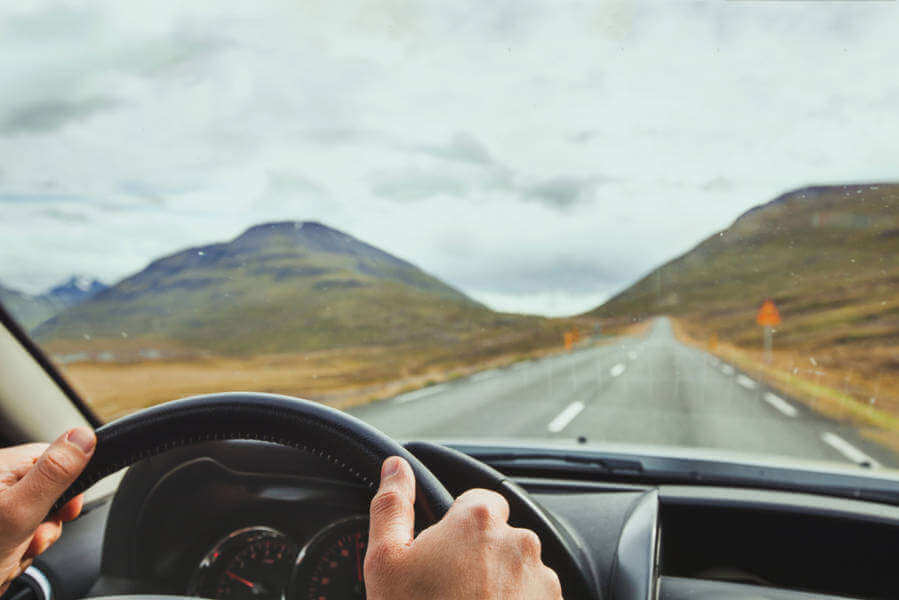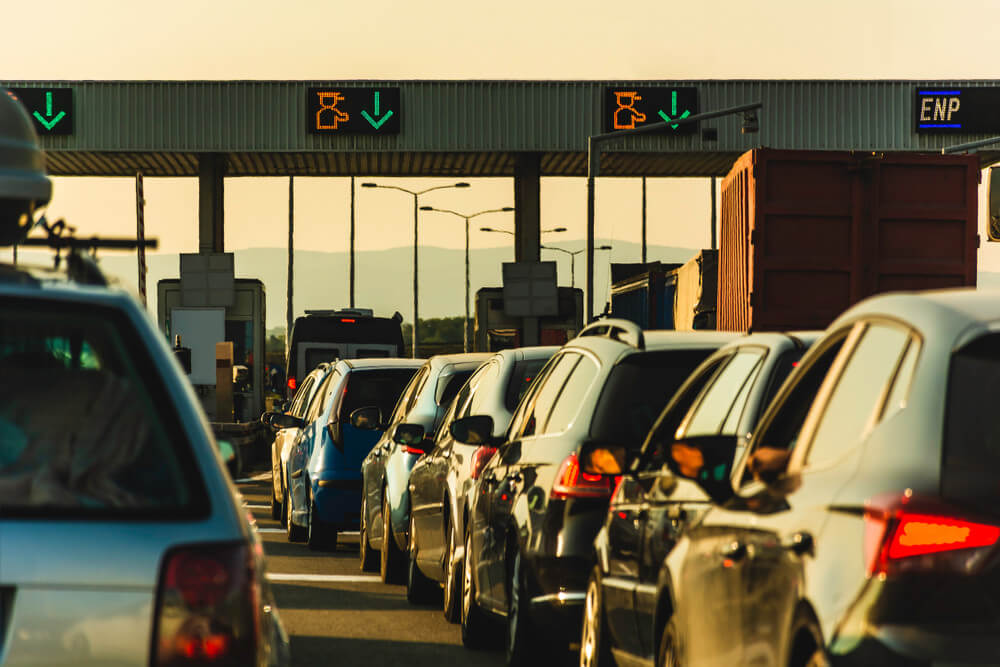February has become a go-to month for many visitors to Iceland for a wide variety of reasons. While road-tripping around the island is by far the best way to explore Iceland and everything it has to offer, driving in Iceland in February can be challenging for some.
This guide will help you decide whether a trip to Iceland in February will suit you and your travel needs and give you all the information as well as helpful tips and advice you’ll need for a memorable and safe journey.
The Allure and Challenges of Winter Driving in Iceland
As with most things in life, driving in Iceland in February has its pros and cons. Here’s what you need to consider for your winter road trip in Iceland:
Why You Should Road Trip Iceland in February
- Visiting Iceland in February means between 10 and 12 hours of darkness every day. While this may not be ideal conditions for many other activities here on the island, it’s prime condition for one of our most spectacular natural phenomena: the Northern Lights!
- February is right after our busy festive and New Year peak season and marks the slow start to the turn of our winter season. This means you’ll find fewer visitors on the island and won’t need to worry about peak season prices (perfect for those traveling on a tight budget).
- The landscape is simply magical and looks like something only Disney could come up with for the Frozen franchise. A thick white blanket of snow, waterfalls seemingly frozen in time with frosty tentacles hanging down cliffs, Icelandic Horses with their thick and fluffy winter coats – it’s breathtaking scenes that can never truly be described in words.
- There are a few activities exclusive to the season. These include exploring the ice caves (most of our ice caves are closed throughout the warmer months) and dog-sledding (a unique experience traversing the Icelandic terrain by being pulled across the snow by a special breed of dog).

Why You Should Not Road Trip Iceland in February
- As we already touched on, February has very limited daylight hours, so this is not the time to visit the island with a jam-packed trip itinerary – there are simply not enough daylight hours for extensive exploration.
- Many of our roads are kept closed throughout the colder months of the year. This includes our famous F-roads, which makes road-tripping our beautiful but remote regions, such as the Westfjords and the Highlands, nearly impossible.
- You might be dealing with extreme weather conditions such as blizzards and ice and snow on the road. Making navigating the roads extremely challenging, especially if you’re not used to such conditions back home.
No matter your decision, rely on us for expert advice and the best winter-ready rentals! If you're ready for a winter adventure, secure the perfect car rental in Iceland today and drive safely through Iceland's stunning winter landscapes.

February Road Conditions in Iceland
Iceland weather in February can be challenging. The following is what you can expect from road conditions when driving in Iceland in February:
Typical Weather Patterns and Their Impact on Driving
The following is what you can expect from our most famous winter weather elements:
- Snowfall: It still snows during the month of February, although less than mid-winter. According to the Icelandic Road and Coastal administration, you can still expect an average of 17.1 cm (+/- 6.7 inches) of snowfall throughout the month. Further north on the island, it might even be slightly more. Snowfall can make the road slippery and impact visibility.
- Temperatures: The temperatures also don’t help the snowy situation, with temperatures ranging between -3 and 3 degrees Celsius (26 and 34 degrees Fahrenheit), causing any melted snow to turn to ice, making roads even more slippery.
- Wind Speeds: Although our winds have calmed down slightly since mid-winter, you can still get wind speeds of up to 25 km/h (15.5 mph). At these speeds, it can sometimes feel like the wind wants to take over the driving of your vehicle.
- Daylight Hours: Daylight hours start at 7 hours a day at the beginning of February and then increase to 10 hours a day by the end of the month. This will impact your travel time since there are no lights along our rural and more remote roads, essentially restricting any road trip driving time outside of the cities and towns to whenever there is daylight.

A Few Additional Regional Considerations
The following are some winter weather conditions to consider whenever you find yourself in specific regions here in Iceland:
- The South Coast – The south of Iceland generally has less extreme winter weather than the north. That being said, the often warmer weather leads to more snow and ice melts, which in turn causes more icy patches once you hit those freezing temperatures again. We especially recommend that visitors be extra careful in naturally wet areas such as waterfalls and hot springs.
- The Eastfjords – Certain areas have a high avalanche risk, which is one of the reasons the Oxi Pass (aka Road 939) is often closed during this time.
- The Westfjords – Even if you were not planning on taking on any F-roads, we highly recommend driving a 4x4 in this remote region. Also, double-check road conditions and attractions during your winter road trip in Iceland since there will often be sudden closures, such as the road to Dynjandi Waterfall.

Road Maintenance and Accessibility
The IRCA (Icelandic Road and Coastal Administration) is responsible for the maintenance of the roads in Iceland. As you can imagine, this becomes an exceptionally important (and challenging!) task during the colder months of the year. In general, you’ll find most of our paved and main roads well-maintained and plowed.
This includes the popular Golden Circle route as well as the Ring Road (aka Route 1), although road conditions can become a bit more challenging up north as well as at the already mentioned Eastfjords near Egilsstadir.

Preparing for Winter Driving
We’re all about safe driving in Iceland and ensuring you a smooth driving experience. Below, you’ll find some important information to help you plan and prep your February road trip to Iceland:
A Few Winter Driving Essentials
The following are absolutely non-negotiables when driving in Iceland in February:
- Winter tires – these are legally mandatory between November and April every year, although the period can be extended based on weather conditions. You may also see studded tires, which look similar to the spike shoes track and field athletes wear and also serve the same goal; more traction. In fact, studded tires have been proven to improve tractions by 30% to 40%, absolutely great in our icy conditions!
- A 4x4 – Whether you opt for a 4x4 beast or a 2WD vehicle with 4x4 as a mode option, these vehicles can make all the difference when it comes to our winter weather and road conditions. If you're planning a February road trip, consider exploring Reykjavik Cars' selection of 4x4 rentals to ensure a safe and comfortable journey.

- A heated Windshield – These nifty inventions ensure you don’t get any nasty snow and ice buildup during harsher weather conditions or storms.
- An ice scraper – These also come in handy when driving in Iceland during the wintertime. Unfortunately, not a lot of rental agents provide these with their rental cars, so please inquire before leaving the lot.
- An emergency kit – We’re not saying become a doomsday prepper or that you need to fear some terrible disaster along your drive in Iceland, but the following items are always a good idea for those “just in case” moments:
- Little shovel, tow rope, and tire chains (these are also things you need to discuss with your rental agent as some automatically provide these with their rentals during the winter season, while others have them as additional extras, and others don’t have them at all).
- Thermal blankets (these don’t take up a lot of space but can make all the difference if you should ever get stuck in our more remote regions during some of the coldest weather conditions in Iceland).
- A flashlight (honestly, this should always be with you when you’re driving, irrespective of where in the world you are. We especially recommend headlamps since that will ensure your hands are free).
- A first-aid kit (once again, a must for driving anywhere. What you do in the first few moments of an emergency can make all the difference)

- Backup power supplies. This may sound strange, but many don’t realize that the cold drains batteries faster. So, always have backup power in the form of portable chargers, etc., to ensure you don’t end up with a dead phone or GPS when you need it the most.
- A few emergency rations. Once again, there’s no need to go overboard, but it’s always a good idea to have some extra water and non-perishables such as nuts or energy bars with you. If you ever find yourself in an emergency situation or you’re just stuck somewhere along the road for a couple of hours waiting for assistance, hunger and thirst won’t be added to your list of concerns.
Recommended Rental Car Types
If you're feeling overwhelmed by all the vehicle options at Reykjavik Cars, we've got you covered. The following choices come highly recommended for safe and reliable car rental in Iceland during winter:
|
Vehicle |
Type |
Average Cost (Per Day, Including an Average Gas Consumption) |
Recommended For |
|
Toyota Land Cruiser |
4x4 SUV |
Between $180 and $220 |
If you’re looking for something built with durability as well as comfort in mind. Very spacious with high seats and can take on most road conditions. |
|
Dacia Duster |
4x4 SUV |
Between $120 and $150 |
If you’re looking for durability without the hefty price tag that comes with it. This vehicle offers durability with budget-friendly fuel consumption. |
|
Suzuki Jimny |
4x4 SUV |
Between $130 and $170 |
If you’re looking for something durable yet compact. Comes highly recommended for our narrow mountain roads. |
|
Kia Ceed |
2 WD (FWD) Economy City Car |
Between $50 and $70 |
These are the ultimate budget-friendly cars but require all the necessary winter gear and accessories and are only recommended for shorter drives in our cities/towns and on our well-maintained paved roads. |
*** Just to give you an idea as to the difference in fuel consumption and affordability, a 4x4 SUV can give you roughly 8 to 12 kilometers per liter and uses Premium fuel at about $2.20 per liter, while a compact car can give you roughly 14 to 18 kilometers per liter, and uses Unleaded 95 at about $2.10 per liter.
Safety Precautions and Best Practices
Below are important information and a few helpful insights to make your trip as safe as possible:
Navigating Mountain Passes and Single-Lane Bridges
As you can imagine, our mountain passes can become especially tricky to navigate during our winter weather and road conditions. So, keep the following in mind when planning your road trip route:
Mountain Passes
- Remember not to include Iceland’s F-roads in your road trip itinerary during this time. You can look for some lowland passes, such as Road 52 to Landmannalaugar, as an alternative solution if you really want to, but even these are mostly closed during the colder months of the year.
- Also, remember that most of the Highlands will be a no-go zone, so don’t even consider some of the Highland shortcuts. Rather use alternative roads and routes such as Road 41.

Single-Lane Bridges
- Remember that single-lane bridges work on a first-come-first-serve basis unless otherwise specified in road signs. Whoever arrives second will yield to oncoming traffic (whoever arrived first).
- There are a couple of notorious single-lane bridges that will require you to pay extra attention and be extra careful. These include the Jökulsarlon Bridge on Route 1, which is exceptionally narrow and can be extremely icy, as well as the Kolugljufur Canyon Bridge on Route 715, which is pretty steep which impacts visibility and can be tricky to navigate with snow and ice.
Utilizing Real-Time Road and Weather Information
The best way of staying on top of Iceland’s weather and road conditions is to check out the current weather conditions and forecasts on the Vedur website and check out current road conditions or planned closures on the Umferdin website.
These sites should also give you a good idea of what to expect while planning your trip. Safetravel.is is also a great way for travelers to stay on top of safety by receiving alerts about any happenings or conditions that may impact their travels.
Legal Requirements and Driving Regulations
Below are some of our basic rules and regulations of the road that you will need to adhere to during your drive in February:
- Stick to Iceland’s speed limits. These are not just suggestions, and you can face a pretty hefty fine if caught (up to $1000!). Although there’s always an exception to the rule, and you need to keep your eyes peeled for any road signs, you can expect speed limits to be 90 km/h on our paved “highway” roads, 80 km/h on gravel roads, and 50 km/h in urban or residential areas.
- Turn your headlights on whenever you’re driving (night or day). This is not just to help you see clearly but also to help others see you.
- Drunk driving is an absolute no-go here in Iceland, and technically, you don’t even need to be close to drunk to get a drunk driving conviction. Our legal alcohol driving limit is just 0.05% BAC (much lower than most countries).
- It is illegal to stop, park, or drive off or alongside the road. This is not just to protect you (the Land of Fire and Ice has all sorts of threats you may not be able to see, such as extremely hot springs below ground) but also to protect our environment. For example, we have a rare moss here on the island that can take up to a decade to repair itself once damaged, and that’s if it’s even able to repair itself at all! If you’re caught “off-roading,” you can face fines of $4,500 or more!
- Always ensure that everyone (the driver and all the passengers) wears their seatbelts whenever the car is in motion. Not adhering to this law can also result in some pretty hefty fines.

The Benefits of Renting a Car in Iceland
After all this, some might feel a little nervous about driving in Iceland in February and start to think about just booking a spot on a guided tour. But there are many benefits to having your own ride here on the island. This includes:
- You are the captain of your own adventure. While most tours go to some of our most famous tourist attractions, having your own car allows you to explore some of our more unexplored areas and hidden gems.
- Your time is your own. No one will tell you when to get off or on your vehicle. You can decide how much time you want to spend where and adjust it as you see fit.
- You don’t need to rely on a tour that’s just a couple of hours to see our infamous Northern Lights; you can hunt them down if and whenever you’d like. As long as conditions are ideal (cold, dark, and dry), you’ll be ready to go.
- It can save you a lot of money. If you have to book and pay for a guided tour spot every time you want to do or see something, you will be spending a lot of money – much more than you would for a rental and gas.

Insurance Considerations for Rental Cars
While there’s no better way to explore the island than via a self-drive, you’ll need to ensure that you have the right and sufficient insurance coverage. It’s always best to have a chat with your rental agent about this. But the following should already give you some guidance as to what coverage to get during a winter drive here on the island (and remember, it’s always better to be safe than sorry!):
- Collision Damage Waiver (often referred to as CDW) – Reduces your liability in the case of an accident. Included by default with Reykjavik Cars!
- Premium insurance package: an insurance bundle that includes, reduced liability (SCDW), gravel protection (GP), theft protection (TP) and on certain vehicles, Sand and Ash Protection (SAAP).
- Platinum insurance package: pretty much the same coverage as the Premium one but with zero deductible!

A Few Additional Helpful Tips and Advice for Driving in Iceland in February
The following tips and advice will also be helpful for your Iceland road trip in February:
- We already mentioned keeping a close eye on weather and road conditions. But a good rule of thumb to follow is to rather stay indoors whenever weather warnings turn orange or red. That’s just asking for trouble, especially if you’re not used to weather and road conditions like we often have during the colder months of the year.
- Do not push your luck with our limited daylight hours. For example, trying to drive from Reykjavik to Akureyri in one day in darkness and our winter weather and road conditions is a disaster waiting to happen.
- Download a few offline maps and have a couple hard copies nearby. Technology and signals can fail you, and then you’ll need a backup plan.
- Save our emergency number on your phone: 112. This number is for all emergencies, from roadside assistance to police and the fire department.
- If you should ever find yourself stranded next to the road, for whatever reason, please don’t get out and attempt walking to find help (unless you know for a fact that you can reach a town or gas station within 10 minutes or less). You may not realize, but our winter weather poses a significant risk of hypothermia. It’s also for this exact reason that it’s recommended to allow the engine to run for at least 10 minutes every hour to stay warm (unless you’re stranded due to the vehicle not working, of course).

FAQs About Driving in Iceland in February
Below are the answers to some of the most frequently asked questions we receive about driving in Iceland in February:
Is it worth renting a car in Iceland in winter?
Yes, renting a car in Iceland during winter is worth it if you're comfortable driving in snowy and icy conditions. A 4x4 vehicle is highly recommended for safety and stability. Be prepared for rapidly changing weather and check road conditions frequently.
Is It Safe to Drive the Ring Road in Iceland in February?
Yes, as one of our main paved roads, you’ll be able to drive our Ring Road all year round. Just keep an eye on the weather and road conditions, especially when traveling in the north and the eastern sections between Egilsstadir and Höfn.
Do You Need an International Driver’s License to Drive in Iceland?
No, as long as you have a valid driver’s license in a language understandable to locals, you don’t need an international driver’s license to drive in Iceland.
Are Gas Stations Open 24/7 During Winter in Iceland?
Whether a gas station is open 24/7 will depend on the gas station. In our larger cities and towns, you will find gas stations that are open 24/7. But in our more remote regions and along our rural roads, you’ll struggle to find a gas station that’s open after 20:00 at night.

What to do if roads close while driving in Iceland?
If a road closes while you're driving, do not attempt to continue. Find a safe place to stop, such as a gas station or designated parking area. Stay updated via road.is and local weather alerts. If needed, contact emergency services at 112.
Are Iceland’s mountain roads open in February?
No, most mountain roads (F-roads) are closed during winter, including February. These roads are only accessible in summer due to harsh weather conditions. Always check road.is for real-time updates.
Travel to Iceland in February and Embrace the Adventure of Winter Driving
As you can see, driving in Iceland in February has its challenges, but it also has plenty of perks, and as long as you follow the rules, guidelines, tips, and advice found in this comprehensive guide of ours, you should have no trouble traveling around the country.
You can have the peace of mind that you’re well-prepared for the journey ahead, so rent your car in Iceland, hit the road, and marvel at our winter wonderland while exploring our magnificent landscapes.


 By
By


